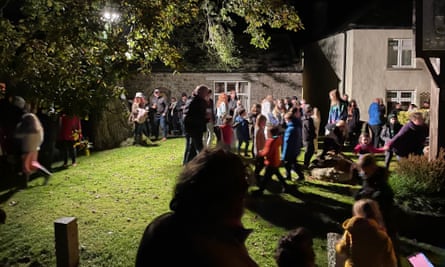A peal of clashing bells echoes across the hills. Hundreds of rooks roosting in the cemetery trees splutter into the darkness. At 7.45pm on 5 November, St Michael’s church bells ring out in discord across the village of Shebbear, in rural west Devon overlooking the Dartmoor hills. On Bonfire Night here, there aren’t fireworks, there isn’t even a bonfire. Instead, there is a stone.
Beneath an ancient oak in Shebbear’s village square is the Devil’s Stone. It’s a sarsen – a foreign stone not from this area. The boulder is thought to be quartz composite, where the local geology is predominantly sandstone and shale. No one attending the ritual turning of the stone on 5 November is bothered what it’s made of. It’s that the stone is turned that matters.
Shebbear’s vicar, Reverend Martin Warren, plays a leading role in the ritual. He says the legend of the Devil’s Stone is that it was dropped upon the devil after a celestial battle with the archangel Michael, trapping him in Shebbear. It is turned every year to avert disaster, Martin says, and ensure he doesn’t “wriggle out from under it”.
Ron Ackland, Shebbear historian and 89-year-old keeper of the village secrets, tells me a slightly different version. “It’s all mythical,” Ron says, “but they used to say that the devil dropped the stone here on his way to Northlew [a nearby village] where he died of the cold.”

The eerie peal alerts the crowd that it’s time to finish their hog roast and gather around the stone, where Martin gives his sermon accompanied by the rustle of oak leaves. The devil gets a good “booing” and then Martin shouts: “To declare the devil does not have the last word, to stand upon the stone of fame, we call upon Shebbear’s ringers!” Here, Shebbear’s bellringers appear brandishing crowbars.
A slow, mesmeric chant of “Turn the stone! Turn the stone!” rises from the crowd as the bellringers heave the rock with their crowbars. The chanting becomes increasingly frenzied as time goes on, with some growing quite impatient. “Go on, turn it!” someone shouts. When the enormous boulder is finally turned, the crowd cheer and children scream. “One year when we turned it,” Ron says, “a rat ran out, and everybody thought it was the devil himself!”
There are various theories about how the stone arrived in Shebbear, but the most likely is that it was deposited by glacial ice, as there are similar “erratic” stones nearby. As to its purpose historically, many believe it is the remnants of a pagan altar stone. It is also thought an Anglo-Saxon parliament gathered around it, since Shebbear was the centre of an Anglo-Saxon “hundred” – the division of a shire for military and judicial purposes under the common law.
Revelations – both pious and heathen – often happen on hilltops with their clear views of the heavens, and Shebbear is at the top of a hill almost 150 metres above sea level. A hilltop with a huge, strange stone would have been an auspicious site for rituals. As to why people started turning it, that’s another mystery. “Anybody who says they know is telling porkies,” Ron says.

The ritual is said to be one of the oldest folk traditions in Europe. Although there is no evidence of the turning before the 20th century, Ron says, “I only turned the stone for about 20 years, and my dad only did it for about 45 years – like the men before.” (The stone has been left unturned twice in living memory, during the two world wars. In the second world war, despite blackouts, this was swiftly rectified to avoid further misfortune.)
The turning drew a crowd in Ron and his father’s day, and some remember it being broadcast on BBC radio in 1946. Then it went very quiet, until recently. In the 21st century, worries about the plight of our planet, have led to a revival in folkloric customs. Such rituals are a means of connecting with an ancestral community that had reverence for the land and believed havoc would ensue if it was treated badly. Last year about 400 people crowded into the square.
after newsletter promotion
This year will be my third “turning” since moving to the area from Lundy, which is part of Shebbear’s ancient ‘“hundred”. Some might say it is – like many rituals – an excuse for a knees-up, and they’d be right. After the turning, everyone goes to The Devil’s Stone Inn for a drink and a dance to the music of Big Al & The Wild Strawberries. But there is more to it than that. “Each place is unique and has its story, both through the land and through its people,” Martin says. “The stone is part of that.”
The stone is cool and damp to the touch, and when turned it smells of mud and moss. Ron says it holds a memory of every man and woman who ever took part in the ritual, for as long as the stone is here, they will be here. “I think the stone is very precious – I really do,” he adds. It is both a communal gravestone and a symbol of renewal.
More than a tale about the devil, the stone and the ritual signify the connection of the stone to the land, the ritual to the people. If I initially mistrusted the chanting of “Turn the stone!”, I subsequently felt solidarity in repeating this in unison. Whatever else my neighbour and I might disagree on, we are in agreement on this: the stone must be turned.
 Top Naija News: Nigerian News, Breaking News Nigeria and World News Top Naija News is a daily news publication in Nigeria, delivering the latest breaking news in Nigeria and around the world.
Top Naija News: Nigerian News, Breaking News Nigeria and World News Top Naija News is a daily news publication in Nigeria, delivering the latest breaking news in Nigeria and around the world.



